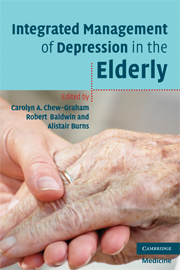Book contents
- Frontmatter
- Contents
- Contributors
- Foreword
- Preface
- Acknowledgements
- 1 Late-life depression: an introduction
- 2 Management of late-life depression
- 3 Management of late-life depression in primary care: case studies UK
- 4 Management of more complicated depression in primary care: case studies UK
- 5 Management of late-life depression across primary and secondary care: case studies UK
- 6 Management of late-life depression around the world: summary of international commentaries
- 7 Resources
- Appendix: International commentaries
- Index
- References
1 - Late-life depression: an introduction
Published online by Cambridge University Press: 18 December 2009
- Frontmatter
- Contents
- Contributors
- Foreword
- Preface
- Acknowledgements
- 1 Late-life depression: an introduction
- 2 Management of late-life depression
- 3 Management of late-life depression in primary care: case studies UK
- 4 Management of more complicated depression in primary care: case studies UK
- 5 Management of late-life depression across primary and secondary care: case studies UK
- 6 Management of late-life depression around the world: summary of international commentaries
- 7 Resources
- Appendix: International commentaries
- Index
- References
Summary
The epidemiology of depression in later life
There is debate about the prevalence of depression in later life. Some authors argue that the prevalence of depression is substantially less than in younger populations (Regier et al. 1993); others, for example Osborn et al. (2003), have found an increase with age in the very old in a large community sample. Recent European studies have found prevalence estimates of between 8.8% and 23.6% (Copeland et al. 1999). This variability reflects a wide range of issues which include the various definitions used, and in particular, the associated diagnostic instruments.
Strict criteria which have high specificity or are mainly designed for research purposes are likely to identify fewer depressed individuals in population studies when compared to instruments adopting broader definitions of depression. The Diagnostic and Statistical Manual (DSM-IV) has tightly defined criteria, whereas the Geriatric Mental State Examination identifies a broader range of depressive conditions. Consequently, when compared with DSM-IV criteria, the latter identifies cases across a number of different DSM-IV syndromes, provided that the individual presents with depressive symptoms of a severity warranting therapeutic intervention. This instrument also identifies people with adjustment disorder and dysthymia as well as major depressive disorder (Newman et al. 1998, Schaub et al. 2003). The close relationship between depression, physical illness and dementia also presents problems for epidemiological investigation. A significant minority of the very old may also experience dementia or high levels of physical illness both of which can mask the clinical presentation of depression.
- Type
- Chapter
- Information
- Integrated Management of Depression in the Elderly , pp. 1 - 16Publisher: Cambridge University PressPrint publication year: 2008
References
- 1
- Cited by



